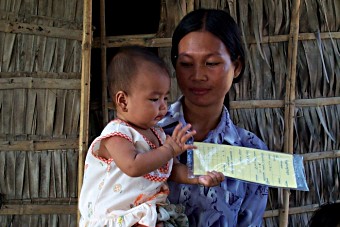
Source: Thor/UNICEF/2010.
Like many developing countries, Cambodia has struggled to make progress toward meeting Millennium Development Goal 5 of reducing maternal mortality by 75%.
Lack of financial resources, political commitment and cohesive leadership have turned complications in pregnancy and childbirth into a leading cause of death and disability among the country's young women, aged 15 to 19 years.
Cambodia's maternal mortality ratio is one of the highest in Asia.
Health system strengthening
In 2002, Cambodia became one of the first countries to benefit from GAVI's health system strengthening support (HSS).
By providing governments with funds to implement national plans for reproductive, maternal, newborn and child health services at the peripheral level, GAVI's support for HSS is designed to ensure health systems like Cambodia's are better geared to the needs of young mothers and their newborn children.
The focus was initially on immunisation delivering, with HSS supporting the introduction of hepatitis B vaccine and injection safety. However, thanks to additional financial help from the United Nations Population Fund and AusAID, the HSS 2 programme has shifted its emphasis to the delivery of integrated services for reproductive maternal and child health care.
Dramatic increases
In addition to reaching or even surpassing immunisation targets for diphtheria-tetantus-pertussis (DTP3) and measles, HSS has seen Cambodia's antenatal care coverage increase dramatically, together with the number of deliveries in health facilities.
Despite this success, much work remains. Scarcity of midwives in Cambodia's rural areas remains a constraint and both strengthening the referral system between communities, health facilities and hospitals, and overcoming barriers to the integration of services are critical to further progress.
